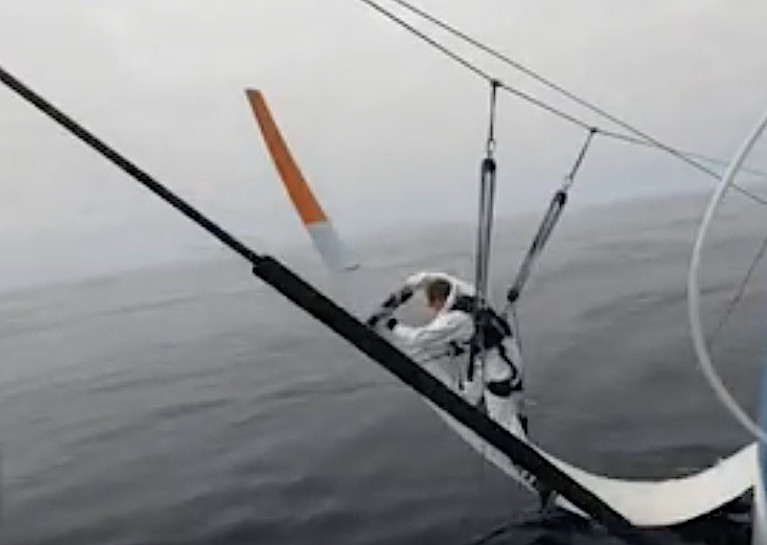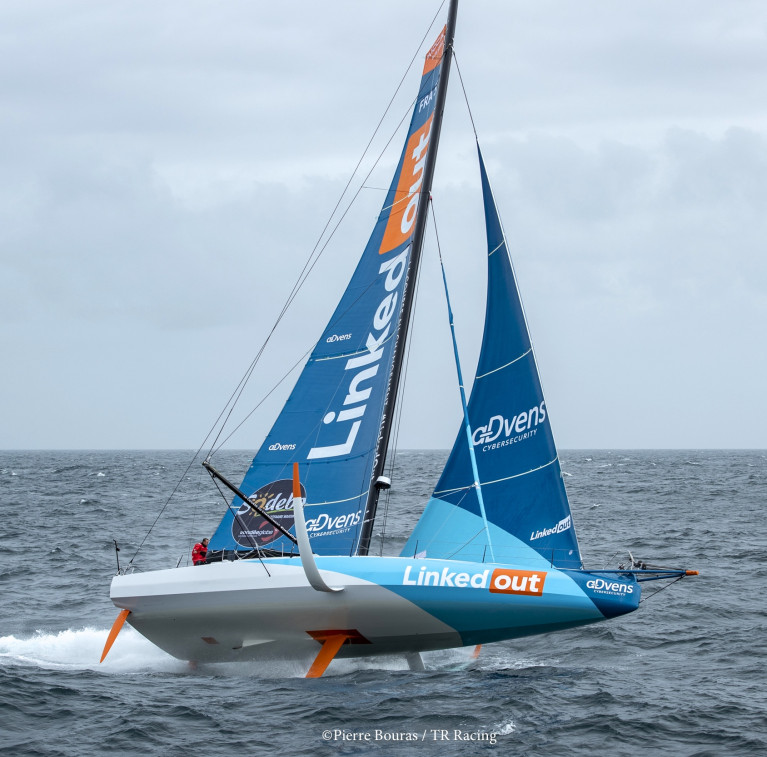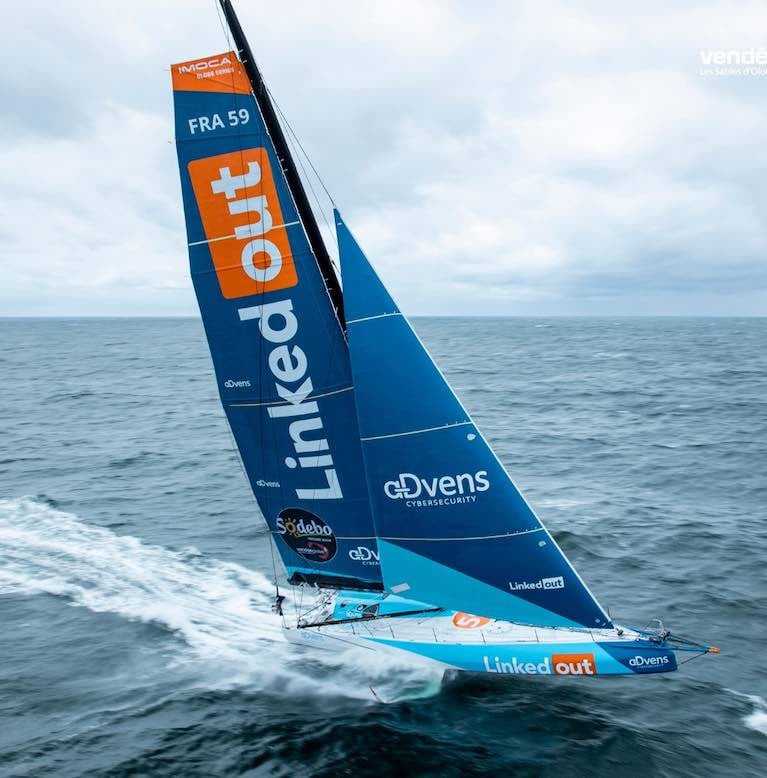Displaying items by tag: Thomas Ruyant
Thomas Ruyant Races to New 24 Hour Record in Retour à La Base Solo Race
With more than 2200 nautical miles still to sail and at least two more low-pressure systems due before a timely finish into Lorient expected Saturday, there is still a long, long way to go on the Retour à La Base solo Transatlantic from Martinique to France.
But as Thomas ‘The Rocket’ Ruyant (For The People) scythed his way into third place today - setting a new solo 24-hour distance record - the top three finishers now hold the podium positions on the outward, two-handed Transat Jacques Vabre. Second into Martinique Yoann Richomme leads, Briton Sam Goodchild, third on the way out, is holding second.
Outbound Ruyant proved quickest downwind in the trade winds, and with his new Koch-Finot Conq design, he has just claimed a new solo monohull 24-hour distance record.
Between 1430hrs UTC Sunday 3rd and 1430hrs UTC today Ruyant is measured to have sailed 539.94 nautical miles. This beats the 2017 record mark of Alex Thomson set on 16th January during the Vendée Globe of 536.81. And with the leaders still making around 22-24kts, there is every chance Ruyant’s new mark might fall again.
Indeed, race leader Yoann Richomme (Paprec-Arkéa) had already come close around 0800hrs this morning and subsequently has been first to go north in search of more breeze and was doing just under 24kts late this afternoon.
The recent winner of the Transat Jacques Vabre Normandie Le Havre with Morgan Lagravière, Ruyant made up the best part of 30 miles and three places during those 24 hours at record speed. This afternoon, he was still about 14 miles behind Sam Goodchild (For the Planet). Early leader Jéremie Beyou (Charal) continues to have technical problems and has set up a secondary wind vane system and lies fourth.
“It looks a little like we saw on the Transat Jacques Vabre that the Koch boats have this edge. They have this quad set up with the smaller J2 and J3s which in certain wind conditions they can set as staysails and it is clearly very effective, they are very much optimised for that configuration. And we can see that again with Thomas who has been on a great run.” Observes The Ocean Race winner Jack Bouttell who was co-skipper on the TJV with Sam Davies.
He continues, “It is interesting to see Yoann gybing for the shift or more pressure, I think mostly the front group will follow each other otherwise. Sam (Davies) has been sailing well and has gybed. She has had a few little breakages, just some fatigue nothing serious but she and Clarisse are having a good race. I am also really impressed by how Violette Dorange is sailing, she is having a fantastic race for her first solo IMOCA race.”
Goodchild said today he felt that as the sea conditions have been building he is at a slight disadvantage compared to the new boats like Richomme’s and Ruyant’s. Nonetheless he was still holding a solid second place and going fast on the opposite gybe to the leader.
Goodchild, at midday: “I have just changed sails which took me a mere one and a half hours and so I am tired. It is fast but the waves are now picking up a bit which is making it a bit difficult for my boat which has not had a new bow put on it and all the boats round me are new boats which are a bit more adapted. I am not going to complain. I have made my hay while the sun shone to be here. I am struggling to keep up to the same speeds now. We have had a wind shift which we did not expect, well I did not expect, and it is a big lefty (header, wind has gone left) so I have changed to my smaller downwind sail and so there are some people who were already on that who might be a little bit slower, so they won’t have to change. And there are others who still will….I think it depends on what they have. Charal are obviously struggling a bit with their wind instruments, when I crossed them yesterday they had a big sail up or a medium sail up. I think Paprec did a second change as I saw them slow down, I am not sure about ‘People’ (For People), I have no plans to gybe soon, as this left wind shift is helping us get north.”
Vendee Globe: Thomas Ruyant's LinkedOut Has Bow Compartment Leak
Thomas Ruyant, who is lying in second place in the Vendée Globe, has slowed his boat to a near halt after discovering that the front bow compartment of his IMOCA LinkedOut was filling with water.
Shortly before 2100hrs Ruyant, who is managed by Ireland's Marcus Hutchinson, has engaged both his main pumps to drain this usually watertight compartment.
The bulkhead doors are closed and so the main living space on the boat is not affected.
As soon as the water is fully evacuated Ruyant will make a complete examination of the boat to make a definitive diagnosis of the problem.
Thomas Ruyant Cuts Foil & is Back in Vendee Globe Race Mode
After cutting off part of his damaged port foil LinkedOut solo skipper Thomas Ruyant is back in full race mode, chasing runaway Vendée Globe leader Charlie Dalin who has escaped into the Roaring Forties, surging eastwards towards the longitude of Cape of Good Hope now with a cushion of 300 miles.
Ruyant cut two metres from the tip of his damaged foil in a perilous operation which was made easier by the unusually clement wind and sea conditions in the South Atlantic. His speeds will be compromised on starboard gybe especially during the ensuing month in the southern oceans but the skipper from north of France is determined to all he can to mitigate any loss of performance.
“Thomas is moving well now and wants to get as far south, to cross the fleet before he gybes over and it is good to see him back in the race at almost full potential. In terms of numbers it is difficult to estimate how much his potential will be compromised, the designers and team are working on estimations to what the new polars would be but the boat is compromised we don’t have the righting moment that we used to, but whether that is ten percent or twenty per cent we don’t know yet. It might be two or three or four knots when the boat is being used at full potential.” Team Manager Marcus Hutchinson suggested on the Vendée Globe Live programme at lunch time today.
With more than 300 miles of a lead Charlie Dalin will be able to modulate his speed in the south on the Verdier designed Apivia. He was averaging more than 20kts at times today, now racing at around 41 degrees south, he gybed at around 0800hrs this Friday morning at around 50 nautical miles north of the Antarctic Exclusion Zone – the virtual ice barrier that the solo racers must stay north of. With around 1300 miles to go to the longitude of the Cape of Good Hope, Dalin should cross on Monday morning.
Finally clear of the sticky clutches of the South Atlantic high pressure the main peloton seem to have been gifted a great weather situation, not least Louis Burton (Bureau Vallée) and Sam Davies (Initiatives Coeur) who were first to break south three days ago. They are lined up on the face of a low pressure system which should catapult them east to close with slightly more wind pressure than their closest rivals to their north. But there is the enduring prospect of a fast, close race between the boats placed second to tenth today.
Yannick Bestaven is fourth this afternoon on Maitre Côq, 14 miles up on Kevin Escoffier (PRB) who in turn is 14 miles ahead of Boris Herrmann (Seaexplorer-Yacht Club de Monaco) 18 miles clear of ARKEA PAPREC sailed by Sébastien Simon. Further to the south Burton and Davies are 12 and 50 miles behind Simon.
Burton continues to impress. The skipper from Saint Malo is on his third Vendée Globe. His boat won the race in 2016-17 in the hands of Armel Le Cléac’h and Burton’s team had already organised its purchase before it had crossed the finish line last January. He trains independently of the IMOCA training groups at Port La Fôret and Lorient and works to a limited budget, such that the VLP-Verdier design is in the same configuration as when Le Cléac’h triumphed four years ago.
In his wake, Sam Davies is getting ready for a change in her conditions aboard: “We’re off now on the conveyor belt. I have been telling myself that this may be the last time we see blue skies for a while, as they are not very common in the Southern Ocean. The solar panels are being fully charged. I’m spending a lot of time outside to stock up with vitamin D before the South.”
There was a similar atmosphere with Kevin Escoffier (PRB), 5th in the fleet on a slightly more northerly route: “The world will be changing for us tomorrow. We’ll be sailing ahead of the front. We’re going to have to be fast to stick with it for as long as possible. You have to know exactly when to gybe in relation to the front to get in the right place for the low-pressure system forecast for 1st December. It will be slamming a bit more with winds forecast in excess of forty knots and heavy seas according to the charts. I cleaned up the boat to get ready for this ‘New World’ ahead of us in the Forties and the Indian Ocean. My next shower will probably involve using the kettle.”
Meanwhile Alex Thomson took the chance last night to further consolidate his repairs on HUGO BOSS before he heads into the big south. But this morning he had the black and pink machine hammer down averaging over 20kts. He is 11th, 661 miles behind Dalin this afternoon. Front of mind will be memories of 2016-17 when he was 819 nautical miles behind Armel Le Cléac’h at Cape Horn but closed that gap to finish 16 hours behind in second place.
“It feels good to be focusing back on the race again and chasing the leaders into the Southern Ocean” Thomson said. “There is a long way to go but I’m feeling good and looking forward to heading downwind finally where I think we’ll really see what HUGO BOSS is capable of”.
Mast Climb For Vendee Globe Leader Thomas Ruyant
Vendee Globe leader Thomas Ruyant (LInkedOut) had a busy night. Since the start, two weeks ago, he was lacking a halyard which has been jammed at the top of the mast. So the skipper climbed the 28-metre rig so he can change downwind sails.
Ruyant, who is managed by Ireland's Marcus Hutchinson, had been waiting for several days for the right moment to carry out these important repairs before he descends into the southern latitudes.
Vendée Globe Has New Race Leader Thomas Ruyant on LinkedOut, Managed By Marcus Hutchinson
The Vendée Globe has a new race leader in Thomas Ruyant on LinkedOut. The solo racer is managed by Kinsale and Howth's Marcus Hutchinson and who, for the second successive Vendée Globe, carries the hopes of businesses, supporters and fans from his home region from the northeast of France, took over the race lead on this morning’s 0400hrs ranking report. After five days at the top of the race classification, Britain’s Alex Thomson (HUGO BOSS) is second today at 26.5 nautical miles behind with Charlie Dalin (Apivia) some 64.5 miles behind Ruyant his compatriot.
It is the first time 39 year old Ruyant, a past winner of the Mini Transat, has lead the Vendée Globe.
“I’ve just looked to this morning’s ranking and I’m in the lead. I’m very happy. It’s nice to be the leader of the Vendée Globe in the South Atlantic but to be honest I am even more happy to be part of this trio with Alex and Charlie. It’s great to be in close contact at this stage of the race. Anyway I am very proud of this being in first place for the first time.” Ruyant said this morning.
 Vendee Globe leader Thomas Ruyant (above) on LinkedOut is managed by Kinsale and Howth's Marcus Hutchinson (below)
Vendee Globe leader Thomas Ruyant (above) on LinkedOut is managed by Kinsale and Howth's Marcus Hutchinson (below)

The Vendée Globe, as always, offers different objectives right through the fleet, something for everyone. And as the 32 solo racers contemplate the start of their third week at sea tomorrow, short term goals are common to the leading trio. They just want to position themselves best to make it onto the same high speed eastwards ride in the Southern Ocean together and not be left behind.
Ruyant, Thomson and Dalin have enjoyed a quick ride down a frontal system passing the latitude of Rio today in favourable breezes but from Sunday afternoon or evening they look set to encounter a zone of much lighter downwind conditions, requiring multiple gybes, a transition area which is a barrier between them and the Southern Ocean.
Behind them, the sheer scale of the race hit some of the younger rookies, racing down the Brazilian coast. Elsewhere the build-up of fatigue starts to affect emotions. And near the back Franco-Australian Seb Destremau (MERCI) is simply enjoying another round the world odyssey, oblivious to the race around him, as he seeks to challenge himself.
Maxime Sorel in 14th on V and B Mayenne, a first timer on the Vendée Globe on a long, long port gybe to the south, racing today off Salvador, Brasil, noted “It is a real step up to be racing on the Vendée Globe! I'm starting to be aware of how long the race will last. For me, I love contact racing, I love manoeuvring, I almost love it when it's hard. This is not my favourite part of the Vendée Globe, it's a bit monotonous. I have the impression that the friends in front are going a little faster. It's getting a bit monotonous; I'm not used to it. We're going to be on the same tack for several days, with not a lot of trimming, no sail changes. It's the first time I've ever been on the same tack for so long. The descent of the South Atlantic is going to be on the same angle, quite tight. It's not very fast for me. My boat isn't super powerful, these are clearly conditions for the foilers, but that's part of the game.”
And Briton Pip Hare, who is having a great race on Medallia in 21st admitted she has been having her ups and downs in the Doldrums, “Sometimes it is easy to get lazy and not do things to the best that you can, and I have to bully myself to make sure I don’t let things slip.” She said on the LIVE show today. Hare is having just the exact match race with Spanish fireman Didac Costa that some predicted, 77 miles of lateral separation, but less than one mile apart in terms of DTF after 13 days racing on two of the most famous boats in the race, Medallia being formerly Bernard Stamm’s Superbigou and Didac’s having started life as Ellen MacArthur’s Kingfisher.
Facing a major repair but with no significant structural issues, just behind Sorel is Isabelle Joshcke (MACSF) whose pushpit and some aft stanchions were ripped from the deck when a sheet block exploded. Joschke is unhurt but will need to improve her security at the back of the boat before she heads into the Big South for the first time.
After a marathon five days of repairs to his mainsail and battens, Japanese skipper Kojiro Shiraishi, is finally back on track with DMG MORI. Having repaired the tear, which was near the top of his mainsail, with laminate cut from below the first reef point Koji, will have to complete his Vendée Globe with a reef in all the time. And, in order to protect the repaired sail, he will only tack rather than gybe – a slightly more time-consuming process but 53-year old Shiraishi is more determined than every to complete this Vendée Globe.
































































